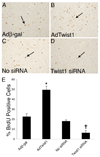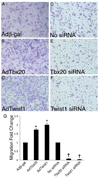Twist1 function in endocardial cushion cell proliferation, migration, and differentiation during heart valve development
- PMID: 18353304
- PMCID: PMC2413172
- DOI: 10.1016/j.ydbio.2008.02.037
Twist1 function in endocardial cushion cell proliferation, migration, and differentiation during heart valve development
Abstract
Twist1 is a bHLH transcription factor that regulates cell proliferation, migration, and differentiation in embryonic progenitor cell populations and transformed tumor cells. While much is known about Twist1's function in a variety of mesenchymal cell types, the role of Twist1 in endocardial cushion cells is unknown. Twist1 gain and loss of function experiments were performed in primary chicken endocardial cushion cells in order to elucidate its role in endocardial cushion development. These studies indicate that Twist1 can induce endocardial cushion cell proliferation as well as promote endocardial cushion cell migration. Furthermore, Twist1 is subject to BMP regulation and can induce expression of cell migration marker genes including Periostin, Cadherin 11, and Mmp2 while repressing markers of valve cell differentiation including Aggrecan. Previously, Tbx20 has been implicated in endocardial cushion cell proliferation and differentiation, and in the current study, Tbx20 also promotes cushion cell migration. Twist1 can induce Tbx20 expression, while Tbx20 does not affect Twist1 expression. Taken together, these data indicate a role for Twist1 upstream of Tbx20 in promoting cell proliferation and migration and repressing differentiation in endocardial cushion cells during embryonic development.
Figures









Similar articles
-
Twist1 directly regulates genes that promote cell proliferation and migration in developing heart valves.PLoS One. 2011;6(12):e29758. doi: 10.1371/journal.pone.0029758. Epub 2011 Dec 29. PLoS One. 2011. PMID: 22242143 Free PMC article.
-
Tbx20 regulation of endocardial cushion cell proliferation and extracellular matrix gene expression.Dev Biol. 2007 Feb 15;302(2):376-88. doi: 10.1016/j.ydbio.2006.09.047. Epub 2006 Oct 3. Dev Biol. 2007. PMID: 17064679 Free PMC article.
-
Tbx20 acts upstream of Wnt signaling to regulate endocardial cushion formation and valve remodeling during mouse cardiogenesis.Development. 2013 Aug;140(15):3176-87. doi: 10.1242/dev.092502. Epub 2013 Jul 3. Development. 2013. PMID: 23824573 Free PMC article.
-
Nfatc1 directs the endocardial progenitor cells to make heart valve primordium.Trends Cardiovasc Med. 2013 Nov;23(8):294-300. doi: 10.1016/j.tcm.2013.04.003. Epub 2013 May 10. Trends Cardiovasc Med. 2013. PMID: 23669445 Free PMC article. Review.
-
TGFβ and BMP signaling in cardiac cushion formation: lessons from mice and chicken.Differentiation. 2012 Jul;84(1):89-102. doi: 10.1016/j.diff.2012.04.003. Epub 2012 May 31. Differentiation. 2012. PMID: 22656450 Review.
Cited by
-
Twist1 transcriptional targets in the developing atrio-ventricular canal of the mouse.PLoS One. 2012;7(7):e40815. doi: 10.1371/journal.pone.0040815. Epub 2012 Jul 16. PLoS One. 2012. PMID: 22815831 Free PMC article.
-
Loss of Gata5 in mice leads to bicuspid aortic valve.J Clin Invest. 2011 Jul;121(7):2876-87. doi: 10.1172/JCI44555. J Clin Invest. 2011. PMID: 21633169 Free PMC article.
-
Critical role for TWIST1 in the induction of human uterine decidualization.Endocrinology. 2011 Nov;152(11):4368-76. doi: 10.1210/en.2011-1140. Epub 2011 Sep 13. Endocrinology. 2011. PMID: 21914771 Free PMC article.
-
Transcriptional regulation of heart valve development and disease.Cardiovasc Pathol. 2011 May-Jun;20(3):162-7. doi: 10.1016/j.carpath.2010.06.010. Epub 2010 Aug 11. Cardiovasc Pathol. 2011. PMID: 20705485 Free PMC article. Review.
-
Functional Analysis of Two Novel Mutations in TWIST1 Protein Motifs Found in Ventricular Septal Defect Patients.Pediatr Cardiol. 2015 Dec;36(8):1602-9. doi: 10.1007/s00246-015-1202-9. Epub 2015 May 19. Pediatr Cardiol. 2015. PMID: 25981568
References
-
- Agarwal P, Wylie JN, Galceran J, Arkhitko O, Li C, Deng C, Grosschedl R, Bruneau BG. Tbx5 is essential for forelimb bud initiation following patterning of the limb field in the mouse embryo. Development. 2003;130:623–633. - PubMed
-
- Alexander NR, Tran NL, Rekapally H, Summers CE, Glackin C, Heimark RL. N-cadherin gene expression in prostate carcinoma is modulated by integrin-dependent nuclear translocation of Twist1. Cancer Res. 2006;66:3365–3369. - PubMed
-
- Barnett JV, Desgrosellier JS. Early events in valvulogenesis: a signaling perspective. Birth Defects Res C Embryo Today. 2003;69:58–72. - PubMed
-
- Bartram U, Bartelings MM, Kramer HH, Gittenberger-de Groot AC. Congenital polyvalvular disease: a review. Pediatr Cardiol. 2001;22:93–101. - PubMed
Publication types
MeSH terms
Substances
Grants and funding
LinkOut - more resources
Full Text Sources
Molecular Biology Databases
Miscellaneous

